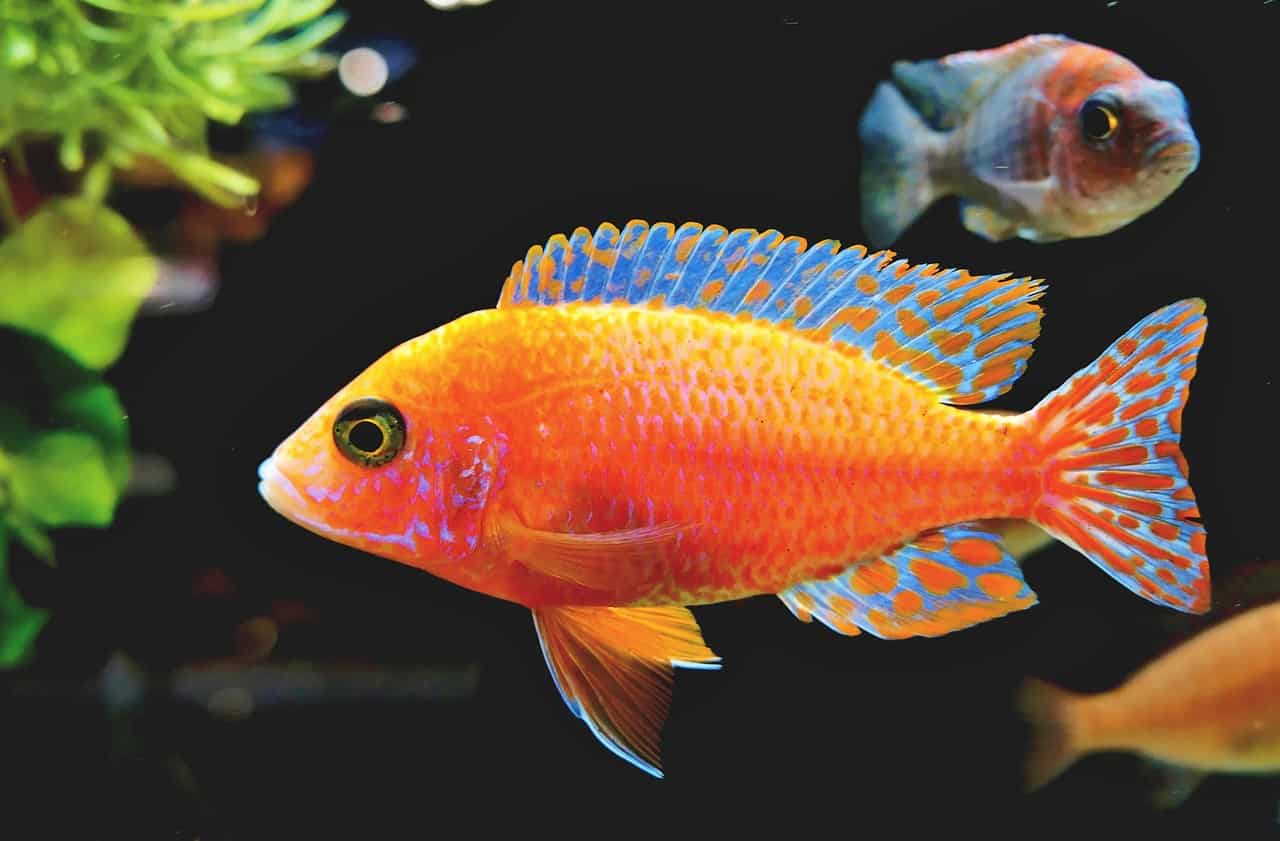Very little information has been collected concerning the reproductive habits of marine Angelfish but more information is coming in all the time.
One study in 1978 by Moyer and Nakazono describes the reproductive habits of Centropyge interruptus, a species that occurs in harems containing a single dominant male and one to four females. The harems exhibit a pecking-order hierarchical system of dominance.
If the male is removed from the harem, the top ranking female will change to the male sex over a period of only two to three weeks. Similar changes have been observed for Genicanthus semifasciatus by Shen and Liu (1975) and for G. lamarck by Suzuki. It appears that harem formation and sex inversion is common among the species of Centropyge and Genicanthus.
Spawning occurs in Centropyge interruptus (Moyer and Nakazono) daily between May and October and seems to be controlled by temperature and light conditions. Spawning will not occur if the temperature drops below 22° C (72° F). The majority of the spawnings take place between 10 minutes before and 5 minutes after sunset unless it was heavily overcast in which case the activities occurred much earlier in the day.
Courtship consists of rapid rushing and circling of individual females by the male. In the final stages before actual spawning the male exhibits a “soaring” display in which he swims high off the bottom above a female and then strikes a motionless pose with all the fines extended. Eventually the female approaches at close range and is “nuzzled” around the abdominal region by the male. This leads to sudden spawning burst in which eggs and sperm are simultaneously released in open water.
The eggs are buoyant and float to the surface where they are planktonic for an unknown time. Moe (1977) reported a hatching time for western Atlantic angelfish eggs of 18 to 30 hours. Monogamous pairing is the reproductive unit of the large Pomacanthus and many of the Holacanthus angels.
The Pomacanthus demonstrate several types of mating systems, dependent on the density of the population at the particular location.They will form either permanent pair bonds, harems consists of a male defending several females in a small area, or (in at least one species) a large group coming together to spawn. In all systems however, these fish spawn in pairs.
Pairs congregate at the edge of the reef at sunset, usually well above the substrate. They often engage in a courtship display where the male and female swim in a brisk head to tail circling motion. Each pair will spawn and ascend into the water column, swimming together in an arc up to about 7 – 10 feet (2 – 3 meters) above the substrate to expel pelagic eggs at the summit. In the large group spawning system they are quite promiscuous, and males will often try to disrupt the spawning of conspecifics.
Holacanthus (including the Queen Angelfish, the Blue Angelfish, and the Rock Beauty Angelfish):
Adult Queen and Blue angelfish are generally found in pairs year round, so it is assumed that the male and the female have a monogamous relationship. Pairs will spawn by slowly rising up in the water column while bringing their bellies close together, and releasing large amounts of eggs and sperm. A female can release anywhere from 25 to 75 thousand eggs each evening. This can total as many as ten million eggs for the duration of the spawning cycle. The eggs are transparent and pelagic, floating in the water column. The eggs will hatch in 15 to 20 hours. At this point the pre-larval angelfish is attached to a large yolk sac, and has no functional fins. The yolk sac is absorbed and during this time the fish develops into true larvae and begins to feed on plankton in the water column. Growth is rapid and 3 to 4 weeks after hatching the fish will reach about 15-20mm and will settle on the bottom.
Butterflyfish – (Chaetodontidae)

Individual butterflyfish species studied up to this time indicate that these fish are gonochoristic, meaning that each fish is either a male or a female,… and they do not change sex!
Marine butterflyfish are not readily sexed as males and females as they do not show different color displays. There are however, a few species in which the male may be larger than the female. The primary visual difference can be seen in the swollen appearance of a female a couple of days prior to spawning.
Very little information has been collected concerning the reproductive habits of saltwater butterflyfish. They are known to have a variety of social structures that include monogamous pair bonds, harems, and schooling (most likely with group spawning). Reproductive behavior is variable and is related to their lifestyles, which in turn is interrelated to the distribution and quantity of food resources.
In the wild, diets vary greatly among the different genera and include live coral polyps, sessile invertebrates, and zooplankton. Butterflyfish are planktivores have a food resource that is temporary and unpredictable, lending itself to schooling fish and they are believed to spawn in groups. While butterflyfish that are corallivorous have a stable and predictable food source, lending itself to the defending of territories in a monogamous and/ or a harem structure with pair spawning. Monogamous pairing can be life-long with some genera.
Butterflyfish have a very definite breeding season, it is related to a seasonal change (depending upon the global location) where the temperature of the water either rises or falls to between 73° – 79° F (22.5° – 25.5° C). Other than group spawners, most species spawn at their feeding territory. But there are also some species that do a migratory spawn. These leave their feeding territory at the end of the day and swim out to the edge of the reef where they set up a temporary smaller territory. Here they spawn and then return to their feeding territory in the morning. Females will spawn once per evening.
Courtship displays can be quite energetic with the spawning pair circling each other head to tail, then chasing each other about, and also shooing away any intruders. Spawning occurs with the male behind and under the female as the pair rise up in the water column forming an arc. At the pinnacle of the arc, several feet above the substrate, they releasing their pelagicgametes into the water column. Often times intruding males will attempt to join the spawn, rising and releasing gametes simultaneously with the spawning pair.
The eggs can hatch anywhere between 1 – 30 days. Butterflyfish have a unique larvae, known as Tholichthys, which are covered with bony plates and have a spiny head. These larvae will remain in a pelagic stage for periods ranging from a few weeks to several months, and then finally move into a benthic lifestyle as juveniles.
Marine butterflyfish have not reportedly been spawned successfully in captivity. There are, however, reports of some success in rearing wild collected larvae of some corallivorous butterflyfish. It is hoped these captive reared fish will be adapted to accept aquarium foods, and thus broaden the species selections that can be sustained in captivity.
Clownfish
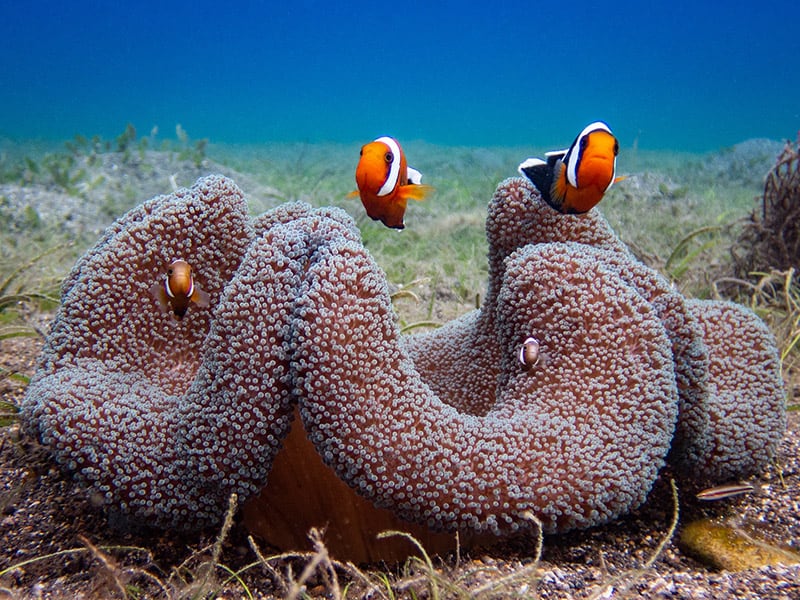
Many clownfish have been successfully bred in captivity. They are among the first marine species to be bred commercially. Most damsels and clownfish are substrate spawners, which means they lay their eggs on the substrate.
Usually, the male takes care of and maintains the eggs after the fish have spawned. He will keep them fanned and protect them against predators.
To breed them get a pair, or purchase six or more of the type you wish to breed. This will help assure that you get a male and a female of the species. The best success is achieved if they are provided a healthy host anemone that they accept.
After they are mature, about a year or so unless you buy a pair, they will clean off a place near the anemone and lay eggs there. The parents will take care of the eggs by defending them against other fish and will frequently fan them. After about 8 days, the eggs will hatch an hour after dark. This is so they have better chance of avoiding predators, including their own parents! From here the fry are on their own and will need infusoria or baby brine shrimp several times a day to survive.
It is a good idea to remove the eggs before they hatch and place them in a separate aquarium devoted to raising the fry. Even so, many of the small fry will die before reaching maturity.
There is also an excellent book available on the propagation of clownfish, Clownfishes, by Joyce D. Wilkerson. It includes sections not only for selecting your breeders but also discusses the spawning and rearing of the fry.
Damselfish
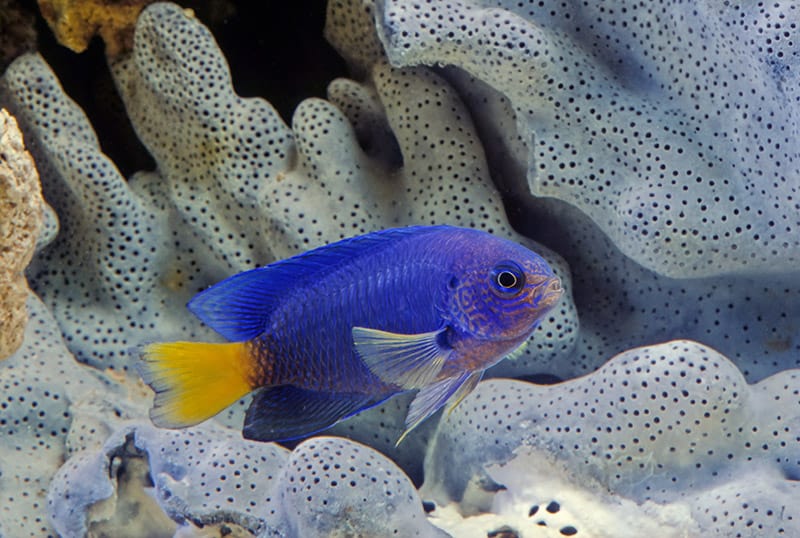
Successful institutional breeding of some species of damselfish has been accomplished in India, also some species have reportedly spawned in home aquariums.
Breeding in the wild
Unlike most saltwater fish species that are pelagic spawners, damselfish just as the clownfish, are substrate spawners which means they lay their adhesive eggs on the substrate. A male damselfish will establish a territory and then clean and prepare an area such as a piece of rubble that has a smoothed-walled crevice, a coral surface, or a rocky ledge for the female to deposit her eggs on.
Once the spawning site has been prepared, the male will then try to attract a female into his territory to deposit her eggs. The male engages in a number of tactics to entice the female to approach involving color changes and excited swimming movements, and in some species emiting clicking sounds. Once the female enters the spawning site, she will deposit up to 20,000 tiny oval adhesive eggs on the prepared smooth surface and then leave. The male will then quickly fertilize the eggs.
Each courtship and mating process takes about 10 to 20 minutes and a male may continue to mate with several additional females. In some species the male will tend the batches of eggs by fanning water across them with his fins, often picking out and eating dead eggs, presumably to prevent a fungus from developing that could threaten the whole batch. Some males provide no direct parental care except to protect the eggs from predators. In all cases, the male will aggressively and fearlessly guard his territory and the eggs from intruders, even fish much larger than himself.
The eggs will hatch in 3 to 7 days. The larvae then drifts away as plankton, feeding on the other zooplankton and phytoplankton for several to many weeks, depending on the species. A damselfish can take from 2 to 3 years or even longer to mature, with each species having its own timeframe.
Breeding in captivity
Reports of the propogation of damselfish has been rather sporadic, though there have been some exciting successes. In India five species have been successfully developed. The Central Marine Fisheries Research Institute in Vizhinjam, Thiruvananthapuram has cultivated the Filamentous- tail Black Damsel Neopomacentrus cyanomos, the Yellow-tail Damsel Neopomacentrus nemurus, the Blue Damsel Pomacentrus caeruleus, the Peacock Damsel Pomacentrus pavo and the Indian Dascyllus Dascyllus carneus.
Hobbyists too have reported some successes in spawning various damsels in the aquarium. Some of these include the Yellow-belly Damsel Amblyglyphidodon leucogaster, Yellow-tailed Damsel Chrysiptera parasema, the Blue Devil DamselfishChrysiptera cyanea, the Fiji Blue Devil DamselfishChrysiptera taupou, the Domino DamselDascyllus trimaculatus, and apparently the Spiny Damselfish, Acanthochromis polyacanthus.
The successful propogation of most marine fish are a challenge to even the most advanced hobbyist, and damselfish are no exception. Probably the biggest reason there has not been a lot more reports about the propogation of damselfish in captivity is due to the commitment required in both time and equipment, which of course ultimately translates into cost. This requires a serious commitment, not only to spawn these fish but to rear the fry as well. As damselfish are inexpensive and readily available, there hasn’t been a large demand for captive reared specimens.
With an increasing interest in the marine hobby today, many people would like to try their hand at raising these fish. Tto help get started propogating damsels in the aquarium, an excellent book is available on the propogation of clownfish (one of the damselfish genera). It is Clownfishes, by Joyce D. Wilkerson and includes sections not only for selecting your breeders, but also discusses the spawning and rearing of the fry.
Hawkfish
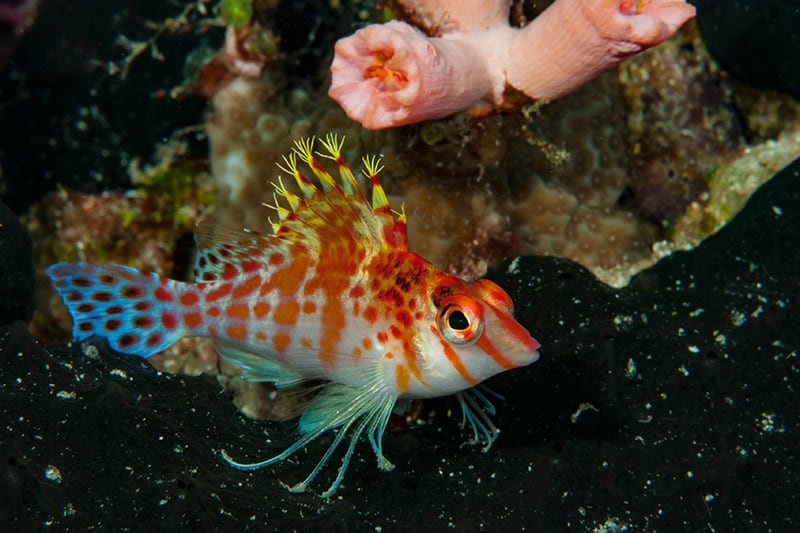
The Longnose Hawkfish is also the only one we know of to have been bred in captivity.
Hawkfish in general, are not sexually dichromatic (different sexes cannot be determined by looks). The Longnose Hawkfish, Oxycirrhites typus, is one exception since the male has an additional black edge on the ventral and tail fins.
Hawkfishes generally live in harems with the largest fish of the group being the male. They are what is called protogynous hermaphrodites, which means that if the male is killed or missing, one of the females will change to a male to fill the gap. This is also believed to be the case with wrasses and angelfish.
The hawkfish spawn at twilight. The male sets up a territory which includes 2 to 7 females. Each night around twilight, he visits each female on her coral block looking for the right ones to court. When he finds a suitable female they swim upwards together in an arch releasing the eggs and sperm together.
Not much is known about the eggs at this point, which are now pelagic, but it is supposed that they spend about 3 weeks in this stage. The fact that they are pelagic for quite some time is used to explain why they are so widely distributed about the ocean.
Although they have not been bred in the aquarium (with the exception of the Longnose Hawkfish), they will set up the territories with the male and several females occupying several different coral branches or blocks.
Lionfish
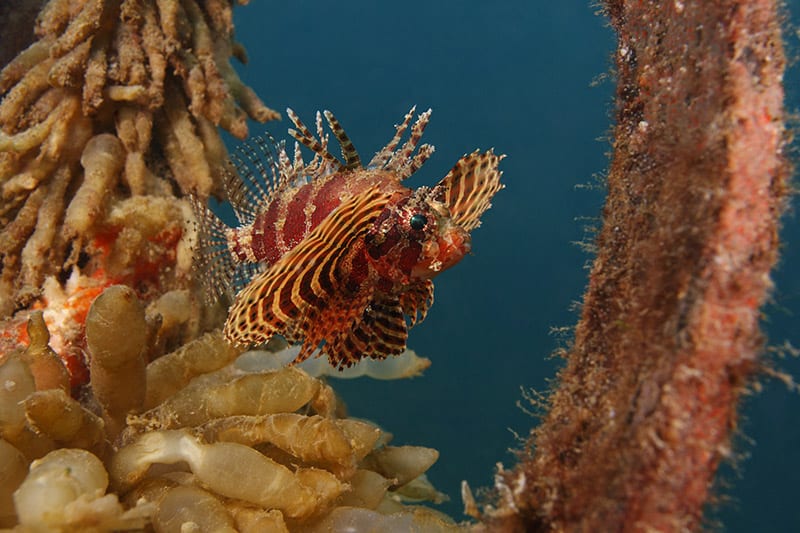
The Shortfin Lionfish is the most often reported as having bred in captivity. They are haremic, which means one male will spawn with a group of females. After courting for an entire day, the fish will spawn around midnight. They will rise to the top of the water column during and release gelatinous balls of eggs, each ball containing about 2000 eggs.
The egg balls will dissolve after about 24 hours releasing the individual eggs. The eggs themselves will hatch after about 36 hours. The fry will immediately feed on the available plankton. As with most fish it is difficult to keep enough plankton in the water to keep the fry alive.
The above information was obtained from Seascope, Volume 15, Summer 1998, in an article by Matthew L. Wittenrich entitled Lionfish: An Overview
Moray Eels
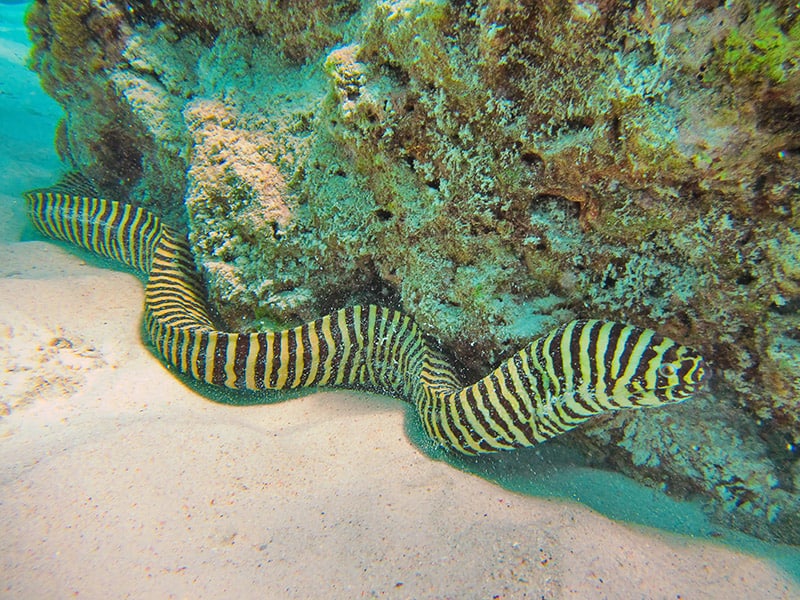
Everything we have found on the breeding moray eels indicates that they are not commonly bred in captivity for several reasons…
They will not breed until they are very large and have outgrown most aquariums. Also, morays, with the exception of ribbon eels, are what is called ‘gonochoristic‘. The female will spawn either as a pair or with several smaller males. At dusk the eggs are released and are basically pelagic. The larval stage of the eel lasts for 6-10 months and so makes it difficult to reproduce in the aquarium.
There are several species of freshwater eels, of the family Anguillidae, that spawn far out in the ocean and release up to 20 million eggs per female. After spawning though, the adults die. The young, called “leptocephali” then travel back to the continental shores where they metamorphose into small eels called ‘elvers’ that then move into freshwater habitats.
Surgeonfish (Tangs)

Some information has been collected concerning the reproductive habits of marine surgeonfish…
Surgeonfish, along with rabbitfish they are gonochoristic (each fish is either male or female) rather than being hermaphrodites. There are few sexual differences, though in some Naso species the males are larger than females. For the others sexual dichromatism exists only during spawning.
Spawnings are tied to the lunar cycle, some surgeonfish will spawn on a new moon and others around the full moon. Many surgeonfish are group spawners, with fish coming together from around the reef late in the afternoon, forming a large aggregate. Others such as the Zebrasoma species, spawn in pairs.
The courtship consists of males searching out gravid females, and then changing colors and performing a shimmering movement to entice the female to spawn. The pair rises together toward the surface in an arc shaped path, simultaneously releasing their gametes into the open water at the apex of the arc. Males may spawn with several females in a single session, while sexually mature females spawn only about once a month.
After hatching, the pelagic larvae subsist on their egg yolk for a couple days and on day four start to feed on plankton. They then begin to develop into a specialized larva, becoming compressed and growing thorns on the dorsal and ventral fins. Their bodies are scaleless and transparent with a silver cast to the abdomen. This post larvae stage is called ‘acronurus larva’, and is distinct to the Acanthuridae. As they grow the body becomes oval, the spines on the caudal peduncle develop, and the thorns on the fins gradually disappear (except on some of the Naso species and on the Blue Tang Paracanthurus hepatus).
The planktonic stage will last about 10 weeks after which the young will then settle into a shallow reef. Though the behavior of the young will vary between species and with the availability of food, many are initially quite territorial. As they mature most species become less aggressive and begin to roam wide areas of the reef in large schools.
Some species of surgeonfish have spawned in public aquariums and there have been a few scattered reports of spawnings in aquariums, but regular spawnings and rearing of the young has not yet been reported.
Triggerfish
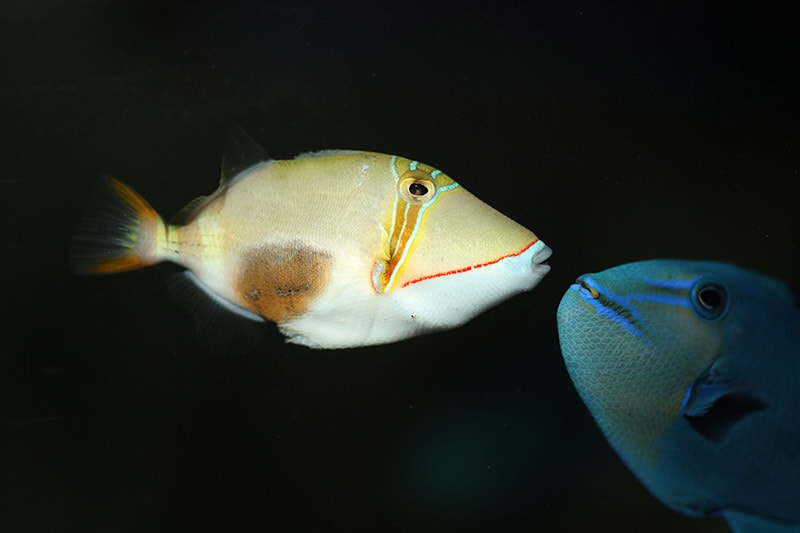
Male triggerfish maintain large territories with several females maintaining smaller territories within the male’s larger territory.
Each female will dig a pit in the sand within their territory which will serve as a place to deposit the eggs. I don’t yet know how long before the eggs hatch, or what the larvae are called.
Featured Image Credit: Ralphs_Fotos, Pixabay
